+ データを開く
データを開く
- 基本情報
基本情報
| 登録情報 | データベース: EMDB / ID: EMD-23214 | |||||||||
|---|---|---|---|---|---|---|---|---|---|---|
| タイトル | Cryo-EM structure of Hsp90:p23 closed-state complex | |||||||||
 マップデータ マップデータ | ||||||||||
 試料 試料 |
| |||||||||
 キーワード キーワード | CHAPERONE | |||||||||
| 機能・相同性 |  機能・相同性情報 機能・相同性情報lung saccule development / prostaglandin-E synthase / prostaglandin-E synthase activity / nuclear receptor-mediated glucocorticoid signaling pathway / prostanoid biosynthetic process / Aryl hydrocarbon receptor signalling / Synthesis of Prostaglandins (PG) and Thromboxanes (TX) / glycogen biosynthetic process / telomerase holoenzyme complex / protein folding chaperone complex ...lung saccule development / prostaglandin-E synthase / prostaglandin-E synthase activity / nuclear receptor-mediated glucocorticoid signaling pathway / prostanoid biosynthetic process / Aryl hydrocarbon receptor signalling / Synthesis of Prostaglandins (PG) and Thromboxanes (TX) / glycogen biosynthetic process / telomerase holoenzyme complex / protein folding chaperone complex / prostaglandin biosynthetic process / sperm mitochondrial sheath / sulfonylurea receptor binding / dATP binding / CTP binding / positive regulation of protein polymerization / vRNP Assembly / Scavenging by Class F Receptors / UTP binding / skin development / sperm plasma membrane / chaperone-mediated autophagy / Rho GDP-dissociation inhibitor binding / Respiratory syncytial virus genome replication / telomerase holoenzyme complex assembly / mitochondrial transport / protein insertion into mitochondrial outer membrane / Uptake and function of diphtheria toxin / Drug-mediated inhibition of ERBB2 signaling / Resistance of ERBB2 KD mutants to trastuzumab / Resistance of ERBB2 KD mutants to sapitinib / Resistance of ERBB2 KD mutants to tesevatinib / Resistance of ERBB2 KD mutants to neratinib / Resistance of ERBB2 KD mutants to osimertinib / Resistance of ERBB2 KD mutants to afatinib / Resistance of ERBB2 KD mutants to AEE788 / Resistance of ERBB2 KD mutants to lapatinib / Drug resistance in ERBB2 TMD/JMD mutants / TPR domain binding / PIWI-interacting RNA (piRNA) biogenesis / Assembly and release of respiratory syncytial virus (RSV) virions / non-chaperonin molecular chaperone ATPase / dendritic growth cone / : / Sema3A PAK dependent Axon repulsion / protein unfolding / positive regulation of cell size / regulation of protein ubiquitination / HSF1-dependent transactivation / response to unfolded protein / skeletal muscle contraction / regulation of postsynaptic membrane neurotransmitter receptor levels / regulation of protein-containing complex assembly / HSF1 activation / telomere maintenance via telomerase / Attenuation phase / chaperone-mediated protein complex assembly / neurofibrillary tangle assembly / axonal growth cone / RHOBTB2 GTPase cycle / positive regulation of lamellipodium assembly / eNOS activation / Tetrahydrobiopterin (BH4) synthesis, recycling, salvage and regulation / DNA polymerase binding / positive regulation of defense response to virus by host / response to salt stress / Signaling by ERBB2 / cardiac muscle cell apoptotic process / positive regulation of telomere maintenance via telomerase / endocytic vesicle lumen / positive regulation of cardiac muscle contraction / Loss of Nlp from mitotic centrosomes / Loss of proteins required for interphase microtubule organization from the centrosome / nitric-oxide synthase regulator activity / telomere maintenance / Recruitment of mitotic centrosome proteins and complexes / activation of innate immune response / Recruitment of NuMA to mitotic centrosomes / Anchoring of the basal body to the plasma membrane / lysosomal lumen / positive regulation of interferon-beta production / response to cold / HSP90 chaperone cycle for steroid hormone receptors (SHR) in the presence of ligand / ESR-mediated signaling / Constitutive Signaling by Overexpressed ERBB2 / protein tyrosine kinase binding / AURKA Activation by TPX2 / VEGFR2 mediated vascular permeability / Hsp90 protein binding / ATP-dependent protein folding chaperone / response to cocaine / neuron migration / Signaling by ERBB2 TMD/JMD mutants / brush border membrane / Constitutive Signaling by EGFRvIII / Signaling by ERBB2 ECD mutants / tau protein binding / Signaling by ERBB2 KD Mutants / DDX58/IFIH1-mediated induction of interferon-alpha/beta / cellular response to virus 類似検索 - 分子機能 | |||||||||
| 生物種 |  Homo sapiens (ヒト) Homo sapiens (ヒト) | |||||||||
| 手法 | 単粒子再構成法 / クライオ電子顕微鏡法 / 解像度: 3.1 Å | |||||||||
 データ登録者 データ登録者 | Lee K / Thwin AC | |||||||||
| 資金援助 |  米国, 2件 米国, 2件
| |||||||||
 引用 引用 |  ジャーナル: Mol Cell / 年: 2021 ジャーナル: Mol Cell / 年: 2021タイトル: The structure of an Hsp90-immunophilin complex reveals cochaperone recognition of the client maturation state. 著者: Kanghyun Lee / Aye C Thwin / Cory M Nadel / Eric Tse / Stephanie N Gates / Jason E Gestwicki / Daniel R Southworth /  要旨: The Hsp90 chaperone promotes folding and activation of hundreds of client proteins in the cell through an ATP-dependent conformational cycle guided by distinct cochaperone regulators. The FKBP51 ...The Hsp90 chaperone promotes folding and activation of hundreds of client proteins in the cell through an ATP-dependent conformational cycle guided by distinct cochaperone regulators. The FKBP51 immunophilin binds Hsp90 with its tetratricopeptide repeat (TPR) domain and catalyzes peptidyl-prolyl isomerase (PPIase) activity during folding of kinases, nuclear receptors, and tau. Here we determined the cryoelectron microscopy (cryo-EM) structure of the human Hsp90:FKBP51:p23 complex to 3.3 Å, which, together with mutagenesis and crosslinking analyses, reveals the basis for cochaperone binding to Hsp90 during client maturation. A helix extension in the TPR functions as a key recognition element, interacting across the Hsp90 C-terminal dimer interface presented in the closed, ATP conformation. The PPIase domain is positioned along the middle domain, adjacent to Hsp90 client binding sites, whereas a single p23 makes stabilizing interactions with the N-terminal dimer. With this architecture, FKBP51 is positioned to act on specific client residues presented during Hsp90-catalyzed remodeling. | |||||||||
| 履歴 |
|
- 構造の表示
構造の表示
| ムービー |
 ムービービューア ムービービューア |
|---|---|
| 構造ビューア | EMマップ:  SurfView SurfView Molmil Molmil Jmol/JSmol Jmol/JSmol |
| 添付画像 |
- ダウンロードとリンク
ダウンロードとリンク
-EMDBアーカイブ
| マップデータ |  emd_23214.map.gz emd_23214.map.gz | 179.4 MB |  EMDBマップデータ形式 EMDBマップデータ形式 | |
|---|---|---|---|---|
| ヘッダ (付随情報) |  emd-23214-v30.xml emd-23214-v30.xml emd-23214.xml emd-23214.xml | 12.7 KB 12.7 KB | 表示 表示 |  EMDBヘッダ EMDBヘッダ |
| 画像 |  emd_23214.png emd_23214.png | 27 KB | ||
| Filedesc metadata |  emd-23214.cif.gz emd-23214.cif.gz | 5.6 KB | ||
| アーカイブディレクトリ |  http://ftp.pdbj.org/pub/emdb/structures/EMD-23214 http://ftp.pdbj.org/pub/emdb/structures/EMD-23214 ftp://ftp.pdbj.org/pub/emdb/structures/EMD-23214 ftp://ftp.pdbj.org/pub/emdb/structures/EMD-23214 | HTTPS FTP |
-検証レポート
| 文書・要旨 |  emd_23214_validation.pdf.gz emd_23214_validation.pdf.gz | 486.3 KB | 表示 |  EMDB検証レポート EMDB検証レポート |
|---|---|---|---|---|
| 文書・詳細版 |  emd_23214_full_validation.pdf.gz emd_23214_full_validation.pdf.gz | 485.9 KB | 表示 | |
| XML形式データ |  emd_23214_validation.xml.gz emd_23214_validation.xml.gz | 7 KB | 表示 | |
| CIF形式データ |  emd_23214_validation.cif.gz emd_23214_validation.cif.gz | 8 KB | 表示 | |
| アーカイブディレクトリ |  https://ftp.pdbj.org/pub/emdb/validation_reports/EMD-23214 https://ftp.pdbj.org/pub/emdb/validation_reports/EMD-23214 ftp://ftp.pdbj.org/pub/emdb/validation_reports/EMD-23214 ftp://ftp.pdbj.org/pub/emdb/validation_reports/EMD-23214 | HTTPS FTP |
-関連構造データ
- リンク
リンク
| EMDBのページ |  EMDB (EBI/PDBe) / EMDB (EBI/PDBe) /  EMDataResource EMDataResource |
|---|---|
| 「今月の分子」の関連する項目 |
- マップ
マップ
| ファイル |  ダウンロード / ファイル: emd_23214.map.gz / 形式: CCP4 / 大きさ: 190.1 MB / タイプ: IMAGE STORED AS FLOATING POINT NUMBER (4 BYTES) ダウンロード / ファイル: emd_23214.map.gz / 形式: CCP4 / 大きさ: 190.1 MB / タイプ: IMAGE STORED AS FLOATING POINT NUMBER (4 BYTES) | ||||||||||||||||||||||||||||||||||||||||||||||||||||||||||||
|---|---|---|---|---|---|---|---|---|---|---|---|---|---|---|---|---|---|---|---|---|---|---|---|---|---|---|---|---|---|---|---|---|---|---|---|---|---|---|---|---|---|---|---|---|---|---|---|---|---|---|---|---|---|---|---|---|---|---|---|---|---|
| 投影像・断面図 | 画像のコントロール
画像は Spider により作成 | ||||||||||||||||||||||||||||||||||||||||||||||||||||||||||||
| ボクセルのサイズ | X=Y=Z: 0.814 Å | ||||||||||||||||||||||||||||||||||||||||||||||||||||||||||||
| 密度 |
| ||||||||||||||||||||||||||||||||||||||||||||||||||||||||||||
| 対称性 | 空間群: 1 | ||||||||||||||||||||||||||||||||||||||||||||||||||||||||||||
| 詳細 | EMDB XML:
CCP4マップ ヘッダ情報:
| ||||||||||||||||||||||||||||||||||||||||||||||||||||||||||||
-添付データ
- 試料の構成要素
試料の構成要素
-全体 : Hsp90:p23 closed-state complex
| 全体 | 名称: Hsp90:p23 closed-state complex |
|---|---|
| 要素 |
|
-超分子 #1: Hsp90:p23 closed-state complex
| 超分子 | 名称: Hsp90:p23 closed-state complex / タイプ: complex / ID: 1 / 親要素: 0 / 含まれる分子: #1-#2 |
|---|---|
| 由来(天然) | 生物種:  Homo sapiens (ヒト) Homo sapiens (ヒト) |
-分子 #1: Prostaglandin E synthase 3
| 分子 | 名称: Prostaglandin E synthase 3 / タイプ: protein_or_peptide / ID: 1 / コピー数: 1 / 光学異性体: LEVO / EC番号: prostaglandin-E synthase |
|---|---|
| 由来(天然) | 生物種:  Homo sapiens (ヒト) Homo sapiens (ヒト) |
| 分子量 | 理論値: 18.720395 KDa |
| 組換発現 | 生物種:  |
| 配列 | 文字列: MQPASAKWYD RRDYVFIEFC VEDSKDVNVN FEKSKLTFSC LGGSDNFKHL NEIDLFHCID PNDSKHKRTD RSILCCLRKG ESGQSWPRL TKERAKLNWL SVDFNNWKDW EDDSDEDMSN FDRFSEMMNN MGGDEDVDLP EVDGADDDSQ DSDDEKMPDL E UniProtKB: Prostaglandin E synthase 3 |
-分子 #2: Heat shock protein HSP 90-alpha
| 分子 | 名称: Heat shock protein HSP 90-alpha / タイプ: protein_or_peptide / ID: 2 / コピー数: 2 / 光学異性体: LEVO |
|---|---|
| 由来(天然) | 生物種:  Homo sapiens (ヒト) Homo sapiens (ヒト) |
| 分子量 | 理論値: 84.781727 KDa |
| 組換発現 | 生物種:  |
| 配列 | 文字列: MPEETQTQDQ PMEEEEVETF AFQAEIAQLM SLIINTFYSN KEIFLRELIS NSSDALDKIR YESLTDPSKL DSGKELHINL IPNKQDRTL TIVDTGIGMT KADLINNLGT IAKSGTKAFM EALQAGADIS MIGQFGVGFY SAYLVAEKVT VITKHNDDEQ Y AWESSAGG ...文字列: MPEETQTQDQ PMEEEEVETF AFQAEIAQLM SLIINTFYSN KEIFLRELIS NSSDALDKIR YESLTDPSKL DSGKELHINL IPNKQDRTL TIVDTGIGMT KADLINNLGT IAKSGTKAFM EALQAGADIS MIGQFGVGFY SAYLVAEKVT VITKHNDDEQ Y AWESSAGG SFTVRTDTGE PMGRGTKVIL HLKEDQTEYL EERRIKEIVK KHSQFIGYPI TLFVEKERDK EVSDDEAEEK ED KEEEKEK EEKESEDKPE IEDVGSDEEE EKKDGDKKKK KKIKEKYIDQ EELNKTKPIW TRNPDDITNE EYGEFYKSLT NDW EDHLAV KHFSVEGQLE FRALLFVPRR APFDLFENRK KKNNIKLYVR RVFIMDNCEE LIPEYLNFIR GVVDSEDLPL NISR EMLQQ SKILKVIRKN LVKKCLELFT ELAEDKENYK KFYEQFSKNI KLGIHEDSQN RKKLSELLRY YTSASGDEMV SLKDY CTRM KENQKHIYYI TGETKDQVAN SAFVERLRKH GLEVIYMIEP IDEYCVQQLK EFEGKTLVSV TKEGLELPED EEEKKK QEE KKTKFENLCK IMKDILEKKV EKVVVSNRLV TSPCCIVTST YGWTANMERI MKAQALRDNS TMGYMAAKKH LEINPDH SI IETLRQKAEA DKNDKSVKDL VILLYETALL SSGFSLEDPQ THANRIYRMI KLGLGIDEDD PTADDTSAAV TEEMPPLE G DDDTSRMEEV D UniProtKB: Heat shock protein HSP 90-alpha |
-分子 #3: PHOSPHOAMINOPHOSPHONIC ACID-ADENYLATE ESTER
| 分子 | 名称: PHOSPHOAMINOPHOSPHONIC ACID-ADENYLATE ESTER / タイプ: ligand / ID: 3 / コピー数: 2 / 式: ANP |
|---|---|
| 分子量 | 理論値: 506.196 Da |
| Chemical component information | 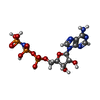 ChemComp-ANP: |
-実験情報
-構造解析
| 手法 | クライオ電子顕微鏡法 |
|---|---|
 解析 解析 | 単粒子再構成法 |
| 試料の集合状態 | particle |
- 試料調製
試料調製
| 緩衝液 | pH: 7.5 |
|---|---|
| 凍結 | 凍結剤: ETHANE |
- 電子顕微鏡法
電子顕微鏡法
| 顕微鏡 | FEI TITAN KRIOS |
|---|---|
| 撮影 | #0 - Image recording ID: 1 #0 - フィルム・検出器のモデル: GATAN K2 SUMMIT (4k x 4k) #0 - 平均電子線量: 70.0 e/Å2 / #1 - Image recording ID: 2 #1 - フィルム・検出器のモデル: GATAN K3 BIOQUANTUM (6k x 4k) #1 - 平均電子線量: 66.0 e/Å2 |
| 電子線 | 加速電圧: 300 kV / 電子線源:  FIELD EMISSION GUN FIELD EMISSION GUN |
| 電子光学系 | 照射モード: FLOOD BEAM / 撮影モード: BRIGHT FIELD |
| 実験機器 |  モデル: Titan Krios / 画像提供: FEI Company |
 ムービー
ムービー コントローラー
コントローラー










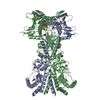


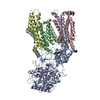





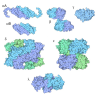











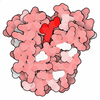




 Z (Sec.)
Z (Sec.) Y (Row.)
Y (Row.) X (Col.)
X (Col.)























